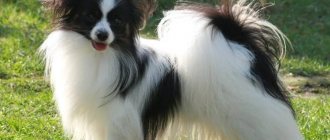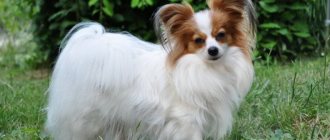The Papillon is a small, beautiful dog with a recognizable appearance. Because of its widely spaced ears, covered with long, hanging hair, the breed was called the “butterfly”. Papillons are cheerful, sociable and intelligent. This is not just a lap dog that will lie on the sofa, but an ideal companion that strives to follow its owner everywhere. This is one of the most popular decorative breeds. But before getting a Papillon, you need to study the description of these dogs, their characteristics, pros and cons, and reviews from owners.
- Head
- Features of education
- Health
Breed traits
Breed traits (on a 5-point scale)
| Papillon | |||
| Activity | in the house | 1.8 | |
| on the street | 2.7 | ||
| Obedience | training | 4.5 | |
| strangers | 3 | ||
| Domination | in family | 1.5 | |
| over dogs | 1 | ||
| Defending your territory | from people | 1 | |
| from dogs | 1 | ||
| Sociability | in family | 5 | |
| with strangers | 3 | ||
| with dogs | 3 | ||
| Concentration | in family | 1 | |
| in front of strangers | 3 | ||
| with dogs | 2 | ||
| Aggressiveness | in family | 2.5 | |
| to strangers | 3.8 | ||
| to the dogs | 3 | ||
| to cats | 2 | ||
| Family behavior | calmness | 4.8 | |
| demand for affection | 5 | ||
| excitability | 2.6 | ||
| playfulness | 3 | ||
| excessive barking | 2 | ||
| behavioral breakdowns | 1.8 | ||
| Tolerance for children | up to 4 years | 4.7 | |
| over 4 years old | 4.8 | ||
| Institutional use | watchman | 1.2 | |
| bodyguard | 1 | ||
This breed is often compared to the following dog breeds: Pomeranian, Chihuahua, Cavalier King Charles Spaniel, Yorkshire Terrier, Jack Russell Terrier.
The photo shows what a Papillon dog looks like:
Rules of education and training
The puppy needs time to learn the rules of behavior in the house and learn commands. It is unreasonable to, say, schedule weekly classes over the weekend, trying to cram the entire educational course into the puppy's mind in hours of intensive training.
Training is done every day, but without overtiring the animal - the dog becomes capricious from overload, can forget what it has learned and, in its own way, will be right in refusing to learn.
Dog handlers combine the “dry” theory of training with play - this way the dog is keenly interested in what is happening and understands everything perfectly.
They start with the minimum. After 2-3 weeks, the puppy remembers the allocated personal place - with a bed, toys, and a bowl. Masters the toilet (puppies wear a diaper at home, they are accustomed to outdoor activities from 2-3 months). Boundaries are outlined for the pet (climbing onto the sofa is allowed, but not on the table or bed). The dog is not allowed to carry and chew the owner's things. They teach you a nickname.
https://dog-care.ru/porody/reyting/papilon-otzyvy-vladeltsev.html
In parallel with education, basic commands are studied:
- "To me". It is practiced when the pet is called for a significant reason - to walk, feed, play, comb out its fur. An uninterested dog will begin to react to words - running up, looking into the eyes expectantly, running away about the dog's business. It will take time to teach her to run up when she hears a command and freeze next to her.
- "Near". Initially, it is studied by walking the pet on a leash. With an obedient dog, in the absence of temptations to run away nearby, they begin to practice unfastening the leash.
- "Ugh". Studied to protect pets from picking up debris from the ground. It is wise to save it for walks, and to stop pranks at home, the prohibitory, easily comprehended command “No” will help.
- "Give". A universal team that adds variety to games with your pet and facilitates its training in individual training courses. The command is practiced with the pet's toys, then with some of the owner's things.
The young dog begins to practice unfamiliar commands at home. After waiting for the commands to be learned, the lessons are repeated in an urban environment - a street, a park, a dog park.
Having turned walks in the fresh air into a puppy's daily routine, he is gradually taught the rules:
- Walk a step away from the owner’s feet, waiting for permission to move away and play;
- Don’t be stubborn about returning home and washing your paws;
- Do not show aggression or obsessive friendliness towards domestic or wild animals;
- Refuse to approach strangers, even those luring you with delicious food.
A pet's education should never be a "mush." It is impossible to simultaneously try to teach him to fetch a ball, walk next to him, or dance funny on his paws in one day. Only when he has mastered one thing can he move on to another.
One of the rules of training is this: the dog’s owner must be a fair friend and leader. Leading dog handlers agree that physical punishment should not be applied to a dog, it destroys its psyche. Disobedience usually occurs due to a person’s inability to establish contact and build relationships. Psychological violence towards a pet is unacceptable, which includes screaming, rudeness in the voice, punishment by ignoring for mistakes. Moderate severity is permitted - but only as a last resort.
And then the owner’s dissatisfaction will become the saddest thing in the world for the dog, which it will try to avoid by all available means.
It is worth mentioning possible incentives:
- Praise in a gentle tone;
- The treat is delicious;
- Affectionate touches.
Training is done by playing with the dog, which has released its pent-up energy and has had its fill of fun.
Often training failures occur due to the inability to attract the dog’s attention, to show it that everything that is happening is serious. She already communicates with the owner every day, but for some reason she must be imbued with the importance of the moment. In education and training, objects that attract attention are used - whistles, rattles.
General characteristics of the Papillon breed
The Papillon is a small toy breed of dog whose beautiful ears resemble butterfly wings. They are widely spaced and covered with long hair. This is why the breed received its name, since papillon is translated from French as “butterfly”. Experts call her a continental toy spaniel, and amateurs call her a “daddy.” Less popular is another variety of the breed - Phalene - with hanging ears.
Papillons love their owners very much, they are loyal and affectionate. They need attention and care and are very sensitive. This is a cheerful and good-natured companion, but always ready to bravely rush to protect his family members. The Papillon is smart, curious and active. Capable of learning tricks, suitable for agility. The breed ranks 8th in the ranking of the smartest dogs.
| Options | Characteristic |
| breed name | continental toy spaniel, papillon or papillon |
| country of origin | France |
| group of breeds according to the ICF classification | decorative dogs |
| height | 20-28 cm |
| weight | 3-5 kg |
| life expectancy | 13-15 years old |
| purpose | companion |
| peculiarities | smart, sociable, active, cheerful |
| aggressiveness | sometimes aggressive, may bite |
| activity | high |
| intelligence | very smart, easy to train |
| attitude towards a person | friendly, loyal, do not tolerate loneliness well |
| care | complex grooming |
| health | good |
pros
The Papillon is a small dog with an attractive appearance and a sociable, cheerful character. It is popular among lovers of decorative breeds and ranks first in intelligence. This is explained by many advantages:
- very smart, quick-witted;
- inquisitive, loves to learn new things, can learn different tricks;
- loyal, accompanies the owner everywhere;
- kind and affectionate;
- easily adaptable, you can take it with you on a trip;
- friendly, loves to play with children;
- cheerful, cheerful;
- does not spoil furniture, does not chew things;
- gets along easily with other pets, except rodents;
- clean, no dog smell.
Minuses
Most of the shortcomings of these dogs are the same as those of other breeds of a similar size. This is a fragile physique, a ringing voice and the possibility of aggression. Papillons also have other disadvantages:
- very active, energetic, love to run;
- you need to carefully select your diet, otherwise you will gain weight;
- may bite painfully;
- requires careful grooming;
- In winter they need clothing and get cold quickly.
This interesting video explains in more detail the pros and cons of the Papillon breed:
Video: Papillon pros and cons of the breed
Pros and cons of multi-colored toy spaniels (papillons) with butterfly ears: character and features
Papillon
The Papillon, a colorful toy spaniel with butterfly ears, is a cute, dwarf animal with French roots. The dog attracts attention with its grace. The most popular breed is the Papillon with erect ears. Also popular are Phalenes - this is a variation of this breed, but their ears are more rounded, and there is a long fringe at their tips. In second place in popularity are Papillons with drooping, teardrop-shaped ears.
Character and features of Papillons:
- These pets, due to their unique character, react animatedly and cheerfully to the attention given by the owner.
- Such an animal is one of the few that immediately senses the approach of danger and turns into a formidable beast.
- The pet cannot tolerate harshness and unceremoniousness towards itself. This royal has its pros and cons.
Advantages of the Papillon breed:
- At an early age, the puppy is easy to train.
- The animal is loved and in demand in society because of a number of positive qualities: playfulness, friendliness, beautiful appearance, affection for the owner, good relationship with children, and so on.
- Intellectual abilities reach their maximum point and ranks first among decorative breeds.
- According to statistics from cynological communities, the dog takes an honorable ninth place among all breeds.
- The dog is distinguished by insight, ingenuity and curiosity.
- He learns commands quickly, carries them out clearly, and does not require praise in return. Sweet sugar for a dog is the delight of the owner.
It is worth noting a few more advantages of this dog, which will help you choose it if you are faced with a choice - to buy a Papillon or a representative of another breed. Here they are:
- Loyalty is the main distinguishing feature of a dog.
- An animal is an owner by nature. For this dog, the main thing is that the owner is nearby and pays attention to it and shows care.
- The Papillon is a lover of travel, easily adapts to any climatic conditions and tolerates any type of transport.
- This breed is a favorite of children; it plays with them cheerfully and fervently. He always treats children's whims patiently and friendly.
- The animal always finds a common language with other pets. Loves cats, unlike other dog breeds.
An animal, like a person, cannot consist of only virtues. The Papillon also has disadvantages:
- Papillon is prone to obesity. Therefore, the dog’s diet must be carefully selected so that the food is healthy and balanced, with a sufficient content of vitamins and microelements.
- Periodic physical activity will help avoid rapid weight gain.
- The Papillon is bell-like in nature. The dog barks at any noise: a knock on the door, a rustle outside the threshold, the arrival of a stranger. Therefore, remember that such pets will be a burden to an overly calm and balanced owner.
Here are a few more disadvantages of the breed that you should definitely pay attention to when choosing a pet:
- The dog does not like large crowds of people. During the holiday, the pet will have to be moved to another room, otherwise the dog will constantly bark and show aggression.
- Before getting a pet, you need to clearly understand that the animal requires proper care to stay in shape. From time to time you will have to invest in cosmetic procedures, which are not cheap at all.
- Regular consultations with a veterinarian are also necessary. The dog is susceptible to luxating patellas (increased bone fragility) and dental problems.
- Wool is a dog's weak spot. If the dog is not given proper attention, is not bathed in a timely manner and is not brushed daily, then the pet will lose its attractiveness and will look like an abandoned mongrel.
When deciding to purchase a dog of royal blood, you need to remember: loneliness is contraindicated for her and she needs to be confident in complete safety. This is a family member that requires attention, love and affection. But, if the dog receives proper care and good attitude, then the Papillon will answer you in the same way.
History of the origin of the Papillon breed
Continental Toy Spaniels have been known in France since the 14th century. They were popular among the nobility. These small beautiful dogs were taken to receptions and balls. Due to their unique attractive appearance and good-natured nature, Papillons were loved by many French kings. That’s what they were called back then – “the lap dog of kings.” These pets can be found in paintings by famous artists.
Only at the end of the 19th century did the breed appear in America, and at the beginning of the 20th century did British breeders become interested in it. These dogs began to be crossed with Spitz dogs, as a result of which modern Papillons have a fluffier coat.
The breed was officially recognized in the 20s of the 20th century and was called the continental toy spaniel. American cynologists divide it into two varieties: the Papillon with erect ears and the Phalene with hanging ears. In Europe, these two breeds are considered separate and their crossing is not allowed. The French standard was adopted in 1934, since then the requirements for the appearance of dogs have remained almost unchanged.
Is it easy to train a Papillon?
Papillons are extremely intelligent dogs. They successfully participate in sports competitions (agility, freestyle). One of my puppies was sold to the UK, and there he won obedience competitions.
Breeder's observations: The Papillon is very easy to train. If you train a dog, it will show excellent results. And thanks to its spectacular appearance, the Papillon often becomes the best dog in the show.
There are food dogs, and there are those who are motivated by toys. Many Papillons are “obsessed” with toys, and the motivation in their case is usually playful.
Description of the appearance of representatives of the Papillon breed
The main feature of the Papillon's appearance is its graceful ears, covered with long, hanging hair. Because of them, the contours of the dog resemble a butterfly. Outwardly, she looks like a plush toy: thick shiny fur, an elegant face with a charming smile, sparkling intelligent eyes. Sometimes the breed is confused with Spitz or Chihuahua, although they have nothing in common. This is a miniature spaniel. The Papillon's height is 20-28 cm, weight is from 2.5 to 5 kg.
Head
The head is proportional to the body, elongated. The muzzle is sharp, slightly pointed, the stop is pronounced. The bridge of the nose is straight, medium-sized, well pigmented. The teeth are sharp and strong. Lips are dry, teeth and tongue are not visible. The eyes are large, but not protruding, almond-shaped. They are dark in color and set low. The look is lively and attentive.
The ears are thin, large, triangular in shape, erect. They are widely spaced, the tips are rounded and directed to the sides. On the outer edge there is long, soft hair hanging down in a fringe. Because of this, the Papillon's head is contoured like a butterfly.
The phalen variety has ears set high and drooping. That's why these dogs were called so: phalène in French moth. All continental toy spaniel puppies are born with floppy ears; differences between breeds are noticeable only by 4 months.
Body type
The physique is graceful. The neck is of medium length, the scruff is pronounced. The back is straight, the lower back is convex. The chest is wide, the stomach is tucked.
The tail is set high and covered with long hair. The dog lifts it up and bends the tip. He can only lightly touch the back, but does not lie on it and does not curl into a ring.
Limbs
The limbs are thin and smooth. The elbows are pressed to the body, the joints are weakly defined. The paws are elongated, the toes are strong, and there is long hair between them. The dog's movements are smooth and graceful.
Coat and color
The coat is shiny, wavy and long. In some places it reaches a length of 15 cm. On the head and the front surface of the paws it is short and smooth. There are featherings on the ears, tail, pants and collar. There is almost no undercoat.
According to the standard, the Papillon can have any color except blue. The main thing is that white color dominates the body. Usually the spots are black or red. Three-color color possible. White markings may be present on the head.
Photos complement the description of the appearance:
Butterfly Papillon dog: how much do puppies cost in the kennel?
Papillon
Sellers - dog breeders - set prices for this breed based on certain factors:
- Age of the dog.
- Availability of documents (passport, pedigree, certificates and veterinary passport).
- Parents have titles. Taking first place will be an advantage and, accordingly, the price will be more expensive.
- Regions of residence of the seller.
- Purebred animal.
- Class and subspecies of Papillon.
Purebred dogs are more expensive than mixtures of two breeds. If you have all the necessary documentation, the cost of the Papillon butterfly dog automatically increases. After all, a completely healthy dog with an excellent pedigree attracts the attention of breeders more than a crossbreed.
There are several types of purchase:
- Much depends on the age of the puppy. Based on this fact, you can purchase puppies from 2.5 months to six months .
- The older the puppy, the cheaper it will cost.
- By type of coat you can buy: short-haired and long-haired, as well as with medium-length wool
There are not many colors, but there are plenty to choose from. It all depends entirely on your preferences:
- Black and white
- White boiling
- Tricolor
- White-red
- Lemon-sable
- Black and sable
- White-lemon
Puppies of the last three colors are in high demand, so you may notice a higher price for these colors. Also, based on the type of purebred and exterior, we distinguish the following categories; the cost of the dog depends on this type:
- Show-class – (show-class). Purebred breeds that fully meet the stated standards. Such a puppy will cost on average from 35,000 to 80,000 rubles .
- Breed class – (breed class). Puppies are purchased for breeding and exhibitions. The cost will be lower than the previous class - from 15,000 to 40,000 rubles .
- Pet-class – (pit-class). As a rule, they are purchased as pets and may have minor disadvantages based on the breed type. And it does not affect the dog’s health in any way. From 5,000 to 25,000 rubles .
Mixed-breed puppies, without visible defects, will cost the breeder an average of up to 10,000 rubles , and “butterflies” without a pedigree will cost up to 15,000 .
Character of Papillons
In addition to their attractive appearance, these dogs are famous for their amazing character. They almost never have a bad mood, they are always cheerful and active. They are interested in everything, they love to learn new things. This is a companion who is ready to accompany the owner and help him in any matter. They are not capricious, they calmly endure any travel and trips.
Papillons only do not tolerate rudeness and disrespect. They have a soft character, so even a rude shout can cause them to become depressed. These pets require attention and affection, they are very sociable, but not intrusive. You can’t pamper them, they are a very smart dog, they will quickly find a person’s weaknesses and begin to take advantage of them.
These dogs are calm with children and patient. They readily support any games and make the child happy. They get along well with cats and other decorative breeds of dogs. But since the toy spaniel is still a hunting breed, it is better not to leave them alone with rodents or birds.
Despite their small size, these dogs can be good watchdogs. Although they are usually friendly towards people, they do not like noise or large groups. With their ringing bark they attract the attention of the owner, and if necessary, they fearlessly rush to defense.
The Papillon is characterized by the following character traits:
- friendliness;
- cheerfulness;
- curiosity;
- intelligence;
- sensitivity;
- devotion;
- sociability;
- responsiveness;
- playfulness;
- devotion;
- determination;
- emotionality;
- touchiness.
The photo complements the characteristics of these dogs:
Features of education
Papillons are smart and easily learn new commands and skills. These dogs are used in agility, freestyle and other sports. They are capable of performing even the most difficult tricks. These dogs understand many words and, thanks to their curiosity, love to learn.
Despite their gentle nature, Papillons require timely socialization and proper upbringing. Without this, they can become aggressive and even bite. The puppy needs to be shown how to behave, and unwanted behavior must be stopped immediately. Education must be consistent and regular. All family members must comply with the same requirements.
Training a Papillon is not difficult, but it is important to structure the lessons in the form of a game. These dogs are often distracted, this also needs to be taken into account and try to interest the pet. Commands are given in a calm, firm voice. Don't yell at or hit your dog. Papillons do not like rough treatment. It is better to use the reward method with affection and treats. By six months, the puppy should have learned the basic commands:
- place;
- to me;
- it is forbidden;
- ugh;
- stand;
- near;
- sit.
The pet must be taught not to beg for food or to pick up anything on the street. It must respond adequately to cars and street noise, to strangers and animals. Conveniently, in dangerous situations on the street you can take your pet in your arms. It is advisable not to allow your dog to sleep on the bed.
You shouldn't spoil your Papillon. Some owners treat decorative pets like toys. But the Papillon is very smart and power-hungry. He will immediately sense the weakness in the owner’s behavior and will take advantage of it. In this case, the pet may become uncontrollable, capricious and playful.
Video about the peculiarities of raising a Papillon:
Video: Meet the Papillon.
Continental Toy Spaniel (Papillon, Papillon) - reviews
- + Leave a review
Leave a review Reset
Svetlanka pharmacist
https://irecommend.ru/content/schaste-kotoroe-vsegda-s-toboi
Good day everyone! I want to tell you about my “treasure”!!! About diamonds??? No, about a dog that I don’t even want to call a dog, a little man! I used to have a shepherd Danka, whom I loved immensely, but he left us without even living for two years, thanks to the “dog hunters” for this, well, I won’t tell this sad story, but after some time we still We decided to make a friend, I didn’t dare to get a big dog anymore, the memories were too painful, so at the family council it was decided to buy a small dog! The choice was up to me, after a long search, thoughts and thoughts, we decided to buy a Papillon. According to its characteristics, it ranks 8th in intelligence and intelligence of all dogs. I was intrigued by how such a little thing could combine such qualities, although honestly I still I’ve been an adherent of the opinion that any dog, even if it’s a poor dog from a shelter, can be taught a lot of things, the main thing is patience and love, it’s simple! Oops, I got off topic again. So they brought us this miracle from Omsk, outwardly I will say, such an unprepossessing little lump, honestly it seemed even scary to me, this is one of those breeds that can be called an ugly duckling, that is, small, just so-so, but now, so lovely and sly little face, although of course there are so many people and so many opinions! So guys, everything they say is true, in fact, she is not short of intelligence and cunning. She quickly learned basic commands, sit, lie down, give me a paw, you can’t... Well, it’s just on the level of what everyone does, so she manages to show such tricks that just spontaneously appear in her little head, often we just roll with laughter ! But I’ll say right away that this is still a dog and it should recognize family members and not take a leadership position, there were problems with this at first, but now everything is fine. She immediately took me for a leader and a friend; you won’t believe it, she is with me everywhere and always, well, of course, except for those cases when I don’t have the opportunity to take her with me. Walking with her tail on my heels, I don’t have to worry about where my friend is, because in 99 percent of cases, she’s next to me. DEVOTION borders on desperate love, THIS IS THE TRUTH. Therefore, to everyone who is still in thought, definitely do not hesitate, this little baby will be YOUR faithful, no, truest friend and will no doubt rush at the enemy several times larger than her in order to protect you!!!!! (just don’t let her do this, it won’t end well anyway), and, one more nuance, this dog is not a “lover” of guests, especially strangers to her, you need to prepare for this, a stranger is certainly not can neither stroke nor “lisp”, there were precedents when my affectionate dog, in the presence of other people and God forbid drunk people, simply turned into a tireless furious animal, but however, this is easily stopped, right there, without delay. Thank you for your attention, and I hope that if you had any doubts about purchasing this wonderful breed, they have already disappeared and you are already looking for your devoted friend......
Mayhuk
https://otzovik.com/review_7818189.html
Advantages:
Friendliness
Flaws:
No
Not long ago my parents gave me a new friend, a Papillon dog. He is very cheerful and friendly. Enjoys communicating with children and other family members. He is always in a good mood, and his appetite is even more so. Although he does not overdo it, he eats almost everything that is given, but he needs to adhere to a special diet (it is not complicated). Gets along well with other animals, they become true friends. But under no circumstances should this dog be spoiled. Everything must be extremely strict. Daily routine, training. This breed of dog is very jealous, and he is unlikely to tolerate competition and because of this, your dog will be in a bad mood.
Samarkin
https://irecommend.ru/content/rebenok-v-vashu-semyu
I considered many small dog breeds before adopting a Papillon puppy. When I came to the kennel, I was wildly delighted with the number of dogs of different breeds. I was allowed to cuddle all the small and large puppies. In the midst of this puppy joy, the smallest, eared animal ran up to me.
I've never met Papillons before. He was very thin and fragile to the touch (this is normal for this breed), the baby with big ears turned out to be the most friendly. He climbed into my arms and began to caress and kiss without taking his eyes off me.
Of course I melted. There was no doubt left - it was mine...the one!
I asked the owner of the nursery in detail about documents, vaccinations, food and walks.
At first glance, everything seemed simple, but no! If you get a Papillon, it means you are bringing a child into your home, believe me, this is really true.
These are very emotional dogs, they rejoice and worry with you. They perfectly sense your mood. They always want to be close to you! This is a very smart breed and easily learns commands. Loves to play and kiss!
This breed does not require special grooming despite its long coat. Yes, it needs to be combed, but not often. This breed's coat is different in that it has no undercoat and, by the way, does not cause allergies (I personally tested it on people with animal allergies).
The dog does not have a specific “dog” smell.
When my puppy was small (from 3 to 6 months approximately) he walked on a diaper, but I did not make any effort to accustom him to this. He understood everything himself. At the same time, we often went for walks, not because he demanded it, but because I took him everywhere and still take him with me.
We walk without a leash, he doesn’t run away. Loves when people pay attention to him. Gets along well with all animals. Our best friend is a cat!
As for nutrition, I think this is individual, we choose dry food and have been using one for the past three years. The other one he simply refuses to eat. Of course he loves all sorts of goodies and checks my packages when I come home.
burulena
https://irecommend.ru/content/lyubov-na-vsyu-zhizn-dobraya-sobaka-s-ushami-babochkami
Our family is a collection of cat people, so I never had a dog. Recently, my husband’s parents decided to go on vacation, and therefore we got to take their dog with us. Lina is a French Papillon (Papillon). She is playful, curious, sweet, and simply adorable.
This is a hunting dog that loves to chase cats, pigeons, and butterflies. She easily finds hedgehogs in the countryside, so it is difficult to keep track of her while walking. The Papillon is a great dog for an apartment, it is small, but smart and loyal. She loves children, and children are simply delighted with her. On the street we kept hearing compliments about our dog!
The dog is very playful, does not like to be alone, she is a real companion. She likes to watch what is happening, be it household chores (in which she definitely needs to participate) or the movement of cars outside the window.
At the same time, if you are sad, the dog senses it and lies down next to you and stops being naughty. We didn't have any problems with it in the morning either. She didn’t wake us up, didn’t jump, and always waited for us to wake up.
Papillons need training, and from an early age. Our Lina took the “young fighter course”, and yet she is not very well-mannered, and in order to achieve something she has to try. But this is rather a question for the owners and the amount of time and effort they spent.
Our dog was home alone most of the day while my husband and I were at work. Maybe we were just lucky, but our furniture remained in perfect order. The only thing that can be noted is that sometimes things were not where they should be (for example, a slipper ended up in the middle of our bed). However, this amused me, because when you see this little face, you no longer want to swear at all.
Dogs of this breed are quite touchy; if the attitude seems rude to them, they can turn away and “pucker their nose.” You have to suck up and apologize.
Also, such dogs require constant care. The fur on the ears, tail and paws must be combed daily, otherwise expect tangles. And cutting the hair from such ears is simply blasphemous!
Bottom line: The French Papillon is a kind dog that can live well in apartment conditions. Representatives of this breed are smart, playful, and love company.
Of course, for a dog to participate in exhibitions, other conditions of detention, labor costs and financial investments are required. We don’t do this because we were just taking a friend.
Like any purebred animal, Papillons are not cheap at all. Although if you don’t need documents, then, as with other types, you can buy it cheaper.
Now our Lina lives with her parents again, and we see each other much less often, but I fell in love with this dog and it simply couldn’t be any other way!
dunk
https://otzovik.com/review_3504300.html
Advantages:
Faithful, beautiful, the most - the most
Flaws:
too expensive
So, hello) I have two dogs of this breed)) I’ll tell you about my dogs at the end of the review) Now let me tell you about the general characteristics of this breed)) These dogs are very loyal and beautiful!) They can die if left without an owner and besides, they won’t need a new owner, because they love him, they will refuse to drink and eat. This breed of dog is royal)! She is beautiful and used to be depicted in paintings!) This breed is even listed in the Red Book)! They don't have fur, but hair, so you won't be allergic to them)! The dogs are very beautiful, they run fast and love to play, they need care and affection) They will love you with all their hearts! Their hair is long and it is strictly IMPOSSIBLE to cut it!!!! These dogs are show dogs! The dogs are very beautiful, for people with a kind soul) I have a boy and a girl)) The boy is tricolor, and the girl is black and white)) I advise you to dig with a frotline (to get rid of all sorts of bad ones)! You need to wash and comb them! Be responsible! If you bought yourself a Papillon, he is small and has almost no hair... You don’t have to worry, they will definitely grow! And that's all) Bye everyone!
ArinaUdina
https://otzovik.com/review_10235044.html
Advantages:
A very cool dog. Easy to train. On the street everyone squeezes him. You can travel together. You can sleep with him in your arms. Faithful dog. Compact.
Flaws:
Barks a lot and loudly. You can comb it once a month. And it takes at least an hour. Tartar on teeth grows quickly. But overall a good breed.
~Good day everyone! My Papillon is five years old. I live in a private house. We walk the dog according to our mood. The dog loves my mother and grandmother very much, but if we are left alone he changes. He's starting to listen very well. We often walk without a leash. Gets along well with cats and other dogs. We flew to Sochi together. We went on different trips by car. For the holidays we color it with hair chalks. This is cool. The dog feels great in a noisy city. Can learn any trick at any age. I think this is the perfect dog.










